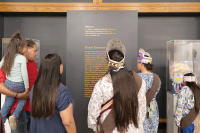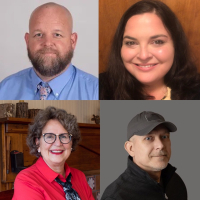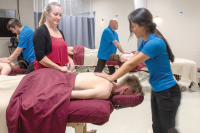The world according to glass
By Michael Beadle
Glass dazzles. It bears no secrets.
It illuminates the world around itself.
Now, thanks to an innovative technique being popularized by artist Harvey K. Littleton of Spruce Pine, glass is revolutionizing printmaking.
Littleton, who is known in the art world as the father of the modern glass movement in the United States, has invited artists from all over the country and abroad to work at his Western North Carolina studio as they develop the art of vitreography, a process which uses glass rather than traditional metal, stone or wood to make prints of paintings, sketches and other two-dimensional pieces.
Related Items
These vitreographs along with glass sculptures, ceramics and hand-made books from more than a dozen artists are on display at Western Carolina University’s Fine Art Museum in Cullowhee. The exhibit, “Harvey K. Littleton + Friends: A Legacy of Transforming Object, Image & Idea,” began in November and continues through March 3.
More than an homage to Littleton and his gifted students and colleagues, the exhibit offers viewers a chance to see science, creativity and experimentation come together in a new art form. While the finished product tends to be the focal point in most exhibits, “Littleton + Friends” tries to explain art as more of a process. A video showing Littleton at work with fellow artists at his studio helps to give a backstory to these pieces, so the viewer may become more interested in the way these works were created than what they look like as finished pieces.
The show features an amazing range of Littleton’s work — vitreographs, a set of finely crafted ceramic teapots, and elegant glass sculptures. (If a pair of high-heeled shoes could be dipped in honey-rose dew and slow-fired to look like diamond ice cubes, Littleton has captured it in one of these glass sculptures.)
There are also a few stunning Dale Chihuly pieces. One of his glass sculptures, a large, faint pink clamshell, opens to reveal perfect spheroid gems like Christmas ornaments from the planet Venus. German-born artist Erwin Eisch offers us a head bust made of glass while Sergei Isupov delivers surreal images of Hieronymus Bosch-like people trapped on the skin of a fantastical beast. There are portraits, landscapes, and collages that show the wide scope of what vitreographs can include.
The idea of vitreography is not exactly new. It was first attempted in Vienna back in the mid-19th century when hydrofluoric acid was poured on polished glass for a Crystal Palace exhibit in London. The process proved to be too expensive, the chemicals too dangerous. Vitreography would have to wait for the 20th century.
Littleton began experimenting with vitreographs in 1974 as a professor of art at the University of Wisconsin. Having grown up near the Corning glass company, where his father worked as a physicist, Littleton would have discussions about the quality of glass at the dinner table and took on a summer job at Corning inspecting hand-blown coffee pots. Drawn to art at an early age, he also had a keen awareness of the science behind art.
After Littleton volunteered for military service in World War II and saw action in North Africa and Italy, he studied at the Brighton School of Art in England and later earned bachelor’s and master’s of fine arts degrees in the U.S. before helping to launch the pottery program at the University of Michigan. A founding member of the American Craft Council, Littleton became a major figure in American ceramics and studio glass. His interests led him to sandblasting plates for printmaking.
Vitreographs, Littleton learned, can be made using different methods. In one method, the glass plate is sandblasted or acid washed. The inked image transfers from the glass plate to paper by way of an etching process. In another method, the image is drawn or painted on a glass plate using water-soluble materials. The non-printed areas are protected by a cured silicone so the areas without the silicone don’t accept ink when the glass is applied with a roller. These images are then transferred to the paper by an etching press.
The results provide more depth of texture and richer, subtler colors than traditional metals and wood plates. The vitreograph is not a painting. It’s not a drawing. It’s a new kind of canvas.
When Littleton retired and moved to Spuce Pine, he set up a glass studio and continued making prints. By 1981, he employed a printer and welcomed artists to come try their hand at the technique of vitreography. Then, thanks to a National Endowment for the Arts grant, he collaborated in the mid-1980s with the Mint Museum of Charlotte to invite painters to his studio and work on the art of vitreography.
As more and more artists learn about the process, expect to see bolder experiments and styles that use glass in a whole new way. “Littleton + Friends” will be open to the public through March 3. After that comes a nationally touring exhibit, “Cleveland Rocks: Photographs of George Shuba” (March 15 to May 4).
For more information about the “Littleton + Friends” exhibit or upcoming exhibits at the WCU Fine Art Museum, go to www.wcu.edu/fapac or call 828.227.3591. The museum is open Tuesday, Wednesday and Thursday from 11 a.m. to 6 p.m., Friday from 11 a.m. to 4 p.m., and the first Saturday of the month from 1 to 4 p.m.









